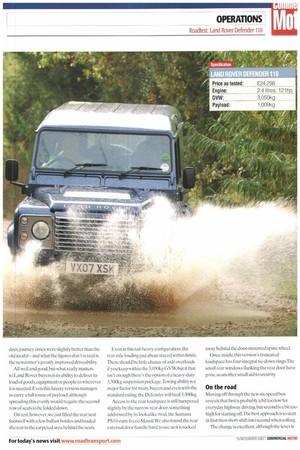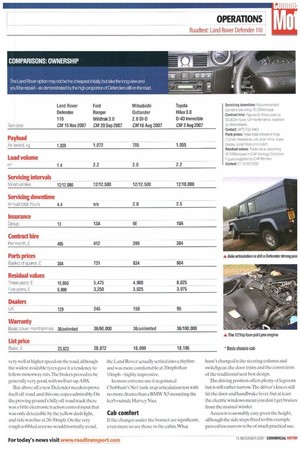IT'S BETTER THAN EVER
Page 44

Page 45

Page 46

Page 47

If you've noticed an error in this article please click here to report it so we can fix it.
0 nly the Queen Mother could have been the subject of more premature obituaries than the Land Rover Defender, Against the odds, in the face of legislative threats in areas such as exhaust emissions and crash protection, the Solihull stalwart has survived to appear in at least one more incarnation.
Key to the latest Land Rover is a foray into the parts bins both at home and at its current parent — from Ford comes a suitably revised iriveline from theliansit, with the Freelander aroviding the new dashboard.
Since 1998 the Defender has only been lvailable with one engine — the last Land Rover-developed unit, the five-pot TD5.This was to have been the first of a modular range :..omprising four and six-cylinder engines, but FIMW came along with its own engines, and he electronically controlled common-rail TD5 :ontinued alone.
It did a good job of bringing the Defender up .0 date,greatly improving torque and economy. 4owever, times move on and earlier this year he TD5 made way for the 24-litre four-pot _ynx engine from the rear-drivenTransit.
Despite giving away 100cc and lhp, it )rovides 360Nm of torque — a 20% hike. It has )een re-engineered to provide a better spread )ftorque,as well as gaining the ability to run on the widely varying quality of fuel likely to be encountered across its global market.
The new engine comes with a six-speed main gearbox; the wider spread of ratios allows a deeper first gear for tough going and a much higher top gear for relaxed high-speed cruising. Having said that, meeting the latest emission regulations has entailed limiting the new Defender's top speed to about 82mph.
The principal means of distinguishing the new vehicle from its predecessor is the bulge in the bonnet (now steel rather than aluminium) which accommodates the taller engine.There are other minor changes—the indicator lenses are clear, and the strengthening ribs along the roof have been reduced in height.
Inside, however, the designers have pushed the boat out. Gone is the old dash that has been around since the last leaf-sprung Series Land Rover disappeared, to be replaced by a stylish assembly based on the latest Freelander.
The extensive Defender range continues with the three nominal wheelbases of 90in, 110in and 130in and the usual mixture of pickups, hard-top vans and station wagons. Three trim levels — base, County and XS — are available, although the XS is limited to stationwagon and double-cab versions Our test vehicle is a 110in station wagon with the no-cost optional utility pack that gives it the front three quarters of a station wagon,with five seats in two rows accessed through four doors, but an unglazed loadspace at the rear.
Productivity
When it comes to fuel economy, the latest Defender doesn't disappoint: its longer legs and better torque helped return laden and unladen figures of 29.1mpg and 31.2mpg respectively. While not in the hatchvan league these figures represent worthwhile improvements of nearly 2mpg over the TD5.
Although increasingly a traffic lottery these
days,jouniey times were slightly better than the old model—and what the figures don't reveal is the newcomer's greatly improved driveability.
All well and good, but what really matters to Land Rover buyers is its ability to deliver its load of goods, equipment or people to wherever it is needed. Even this luxury version manages to carry a full tonne of payload, although spreading this evenly would require the second row of seats to be folded down.
On test, however, we just filled the rear seat footwell with a few ballast bottles and loaded the rest in the carpeted area behind the seats Even in this tail-heavy configuration, the rear axle loading just about stayed within limits. There should be little chance of axle overloads if you keep within the 3,050kg GVW, but i' that isn't enough there's the option of a heavy-duty 3,500kg suspension package.Towing ability is a major factor for many buyers and even with the standard rating, the Defender will haul 3,500kg.
Access to the rear toadspace is still hampered slightly by the narrow rear door. something addressed by its lookalike rival, the Santana PSI 0-cum-Iveco MassifWe also found the rear external door handle hard to use as it is tucked
away behind the door-mounted spare wheel.
Once inside,this version's truncated loadspace has four integral tie-down rings.The small rear windows flanking the rear door have gone, as another small aid to security.
On the road
Moving off through the new six-speed box reveals that first is probably a bit too low for everyday highway driving.but second is a bit too high for starting off.The best approach is to start in first then short-shift into second when rolling.
The change is excellent, alth ough the lever is
a bit further back than feels natural so it is easy to assume you are in sixth when you are in fifth, for example.The Defender keeps the traditional Land Rover secondary lever-move it back and forth for high/neutral/low or left to lock the duff -although it is now supported (or largely supplanted) by the electronic traction control.
The hill descent control of models higher up the Land Rover range isn't available, but as the Defender is more likely to he driven by more experienced drivers this may not he a problem. The only issue with the transmission is the need to be extra smooth to cope with the level of driveline hack lash, which is disappointing fora new vehicle and considerably worse than this tester's own 14-year-old Discovery.This feature felt even worse with a full load.
The Ford-engined Defender is fractionally slower off the line than theTD5; the only significant improvement is the 1.2sec knocked off the 64-96km/h time. But the ligures belie the greatly improved flexibility and refinement; it can keep up with most other road users and surprise quite a few. Noise levels arc lower than ever before, especially at higher speeds... it's finally possible to listen to the radio on the motorway. But at lower speeds the driveline feels harsher and less refined, without the smoothness of the TD5.
In the ride and handling stakes the Defender is not really happy with a full one-tonne load. Despite that adequate axle loading reserve, the steering still felt rather light and nervous. But with half the load left at the test track, full composure was regained The ride is at its worst on medium-speed, poorly surfaced urban roads but it treats speed humps with disdain. It rides very welt at higher speed on the road, although the widest available tyres gave it a tendency to follow motorway ruts:113e brakes proved to be generally very good,with well set-up ABS.
But above all a new Defender needs to prove itself off-road, and this one copes admirably. On the proving ground's hilly off-road track there was a little electronic traction control input that was only detectable by the yellow dash light, and ride was fine at 20-30mph. On the very rough cobbled area we would normally avoid, the Land Rover actually settled into a rhythm and was more comfortable at 20mph than 10mph—highly impressive.
In more extreme use it negotiated Chobham's Not tank-trap articulation test with no more drama than a BMW X5 mounting the kerb outside Harvey Ni.
Cab comfort
If the changes under the bonnet are significant, even more so are those in the cabin. What hasn't changed is the steering column and switchgear, the door trims and the constraints of the traditional seat box design.
The driving position offers plenty of legroom but is still rather narrow.The driver's knees still hit the door and handbrake lever, but at least the electric windows mean you don't get bruises from the manual winder.
Access is reasonably easy given the height, although the side steps fitted to this example proved too narrow toile of much practical use.


























































































































































































